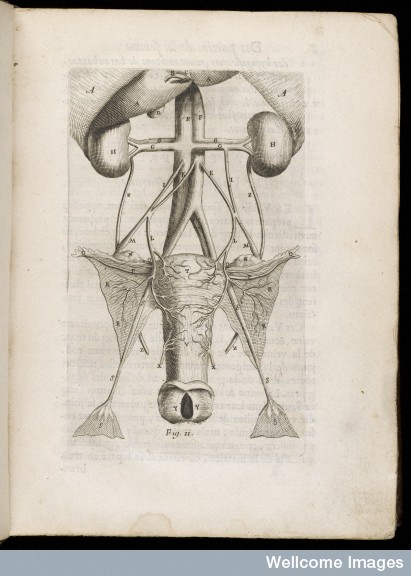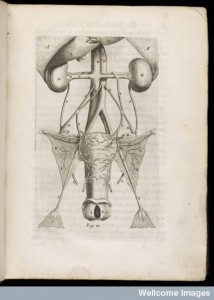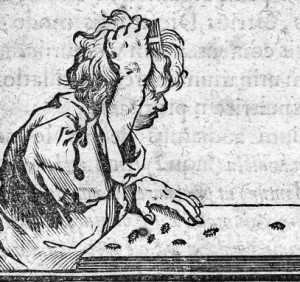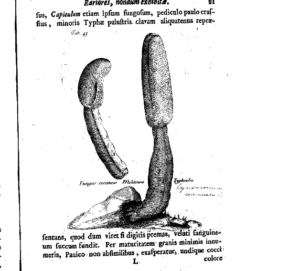
Welcome everyone to the last post before the summer break. Sara and I will be back in the autumn with lots of new ideas and materials. Have a lovely time enjoying the sunny weather. In the mean time we leave you with a discussion of post-partum incontinence.
In early modern England ‘a typical woman would expect to give birth only four or five times after getting married in her mid-twenties’.[1] This figure is lower than many suppose, but is still a significant number of labours and births. One risk of giving birth multiple times is uterine prolapse for which many treatments with pessaries to support the womb were described in medical books.[2] Another possible side effect from multiple pregnancies could be stress incontinence. Modern studies have found that various ‘obstetric factors such as length of the second stage of labor, head circumference, birth weight, and episiotomy [cut to the perineum]’ have a bearing on whether a pregnancy might lead to this condition.[3] Women nowadays are widely advised to do pelvic floor exercises to strengthen their muscles to limit the chances of developing stress incontinence.[4]
This condition is referred to in early modern medical texts as a known complication of pregnancy, but is not discussed as widely as other complications such as prolapses or heavy post-partum bleeding. For example, Jane Sharp only briefly includes it in a list of the potential ‘Diseases of Women’.[5] However, a translation of François Mauriceau’s midwifery guide explains that the position of the bladder in relation to the womb makes this complication unsurprising: ‘The scituation of the Bladder, which is placed just upon the Womb, is sufficient to instruct us wherefore pregnant Women are sometimes troubled with difficulty of urine, and the reason why they cannot often hinder, nor scarce retain their water’.[6]

A typical anatomy of female genitalia described how the ‘nymphae’ [the labia minora] are so called because ‘they stand next to the urine as it spouts out from the Bladder, and keep it from wetting the Labia [labia majora]’.[7] Rough handling of these parts was one thing which is described in medical books as a potential cause of damage to the bladder. Best selling reproduction guide Aristotle’s Masterpiece described how:
In case the neck of the Womb be so strait that the Yard cannot enter, then the is the case to be inquired into […] let no man by violence endeavour in attempting Copulation to force the Passage, lest he break the Vessels, nay indanger the Bladder itself, which has been broke with such violent Intrusion, and so cost the Woman her life.[8]
This passage then went on to describe how overflowing of the ‘Urinal Vessels’ was considered by pseudo-Aristotle to be a possible cause of failure to conceive.

In the later seventeenth century, John Pechey made use of Mauriceau’s midwifery guide to describe how in pregnancy incontinence was one side of the coin but that the pressure of the advanced pregnancy might equally hinder passing water, and prescribed a belly band to reduce the pressure, but ultimately offered the advice to stay in bed:
If incontinence or difficulty of Urin be occasion’d by the weight and bigness of the Belly, the Woman may remedy it, and ease her self, if when she wou’d make water, she lift up with both her hands the bottom of her Belly, or she may wear a large Swaith [support] fitted for this use, to bear up the Belly, but the best way is to keep her in Bed. […] But if the Woman notwithstanding she observes these directions cannot make water, it must be drawn out with a Catheter by an Artist.[9]

The qualification of ‘by a Artist’ or practitioner of the art of midwifery, being Dionis’s addition to Mauriceau’s text. Pierre Dionis’s midwifery guide also agreed that the best treatment for incontinence in pregnancy was bed rest. His guide to midwifery made a connection between prolapse and incontinence when he wrote that this was a rare complication of pregnancy whereby the womb in the first few months of pregnancy might prolapse into the vagina and block the egress of urine. However, Dionis remarked that that urinary incontinence was almost inevitable in late pregnancy. There was no cure, he claimed, only the treatment of remaining in bed, but if the patient was unwilling to ‘submit to that, to have Patience, knowing that it will be over as soon as she is deliver’d’.[10] This strongly implies that the incontinence was considered to be temporary as a result of the pressure of the advanced pregnancy and takes no account of the permanence of damage to the ligaments, muscles and so forth that might leave a woman prone to stress incontinence permanently. This means there is a gap in our understandings of how many women were left with any degree of temporary or permanent stress incontinence as a result of repeated pregnancies.
(c) Sara Read, all rights reserved
________________________________________________
[1] Adrian Wilson, ‘The Ceremony of Childbirth and its Interpretation’, in Women as Mothers in Pre-Industrial England: Essays in Memory of Dorothy McLaren, ed. by Valerie A. Fildes (London: Routledge, 1990), pp. 68-107 (p. 68).
[2] Sara Read, Menstruation and the Female Body in Early Modern England (Basingstoke: Palgrave, 2013), p. 108.
[3] L. Viktrup, L., G. Lose, M. Rolff, K. Barfoed, ‘The Symptom of Stress Incontinence Caused by Pregnancy Or Delivery in Primiparas’, Obstetrics and Gynaecology, June 1992 <http://journals.lww.com/greenjournal/Abstract/1992/06000/The_Symptom_of_Stress_Incontinence_Caused_by.11.aspx>.
[4] See ‘What are Pelvic Floor Exercises?’ <http://www.nhs.uk/chq/Pages/1063.aspx#close>
[5] Jane Sharp, The Midwives Book (London, 1671), p.254.
[6] François Mauriceau, The Diseases of Women with Child, and in Child-bed (London, 1672), p. 79.
[7] Thomas Gibson,The Anatomy of Human Bodies Epitomised (London, 1682), p. 80.
[8] Anon., Aristotle’s Masterpiece (London, 1684), pp. 80-81.
[9] John Pechey, A General Treatise of the Diseases of Maids, Bigbellied Women, Child-bed-women, and Widows (London, 1696), pp. 98-100.
[10] Pierre Dionis A General Treatise of Midwifery (London, 1719), p. 135.





In the 19th century there was a bylaw in the Metropolitan District of London that allowed pregnant women to pee in the streets. They first had to shout “urgent need” in the four principal compass directions then they could squat down and relieve their bladders without fear of legal redress.
That’s interesting Thony, thanks for your comment. I wonder if the law was in response to it being made illegal to pee in the streets at some stage and this was brought in as an exception? I’m reminded of the perennial debate that pops up about women being ‘allowed’ to pee in a police officer’s helmet too. There was even a discussion thread on the Guardian about that one:
http://www.theguardian.com/notesandqueries/query/0,5753,-12452,00.html
The bylaw exempting pregnant women was certainly a reaction to a bylaw banning peeing in the streets